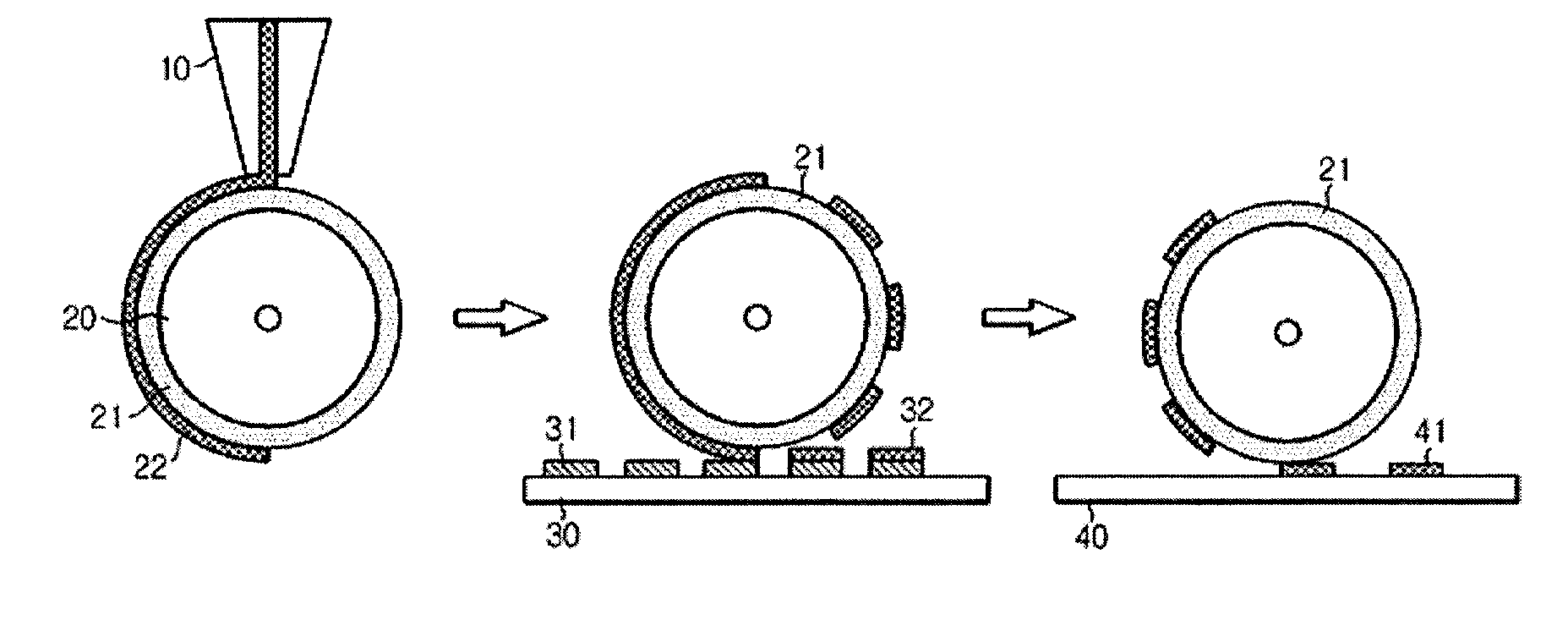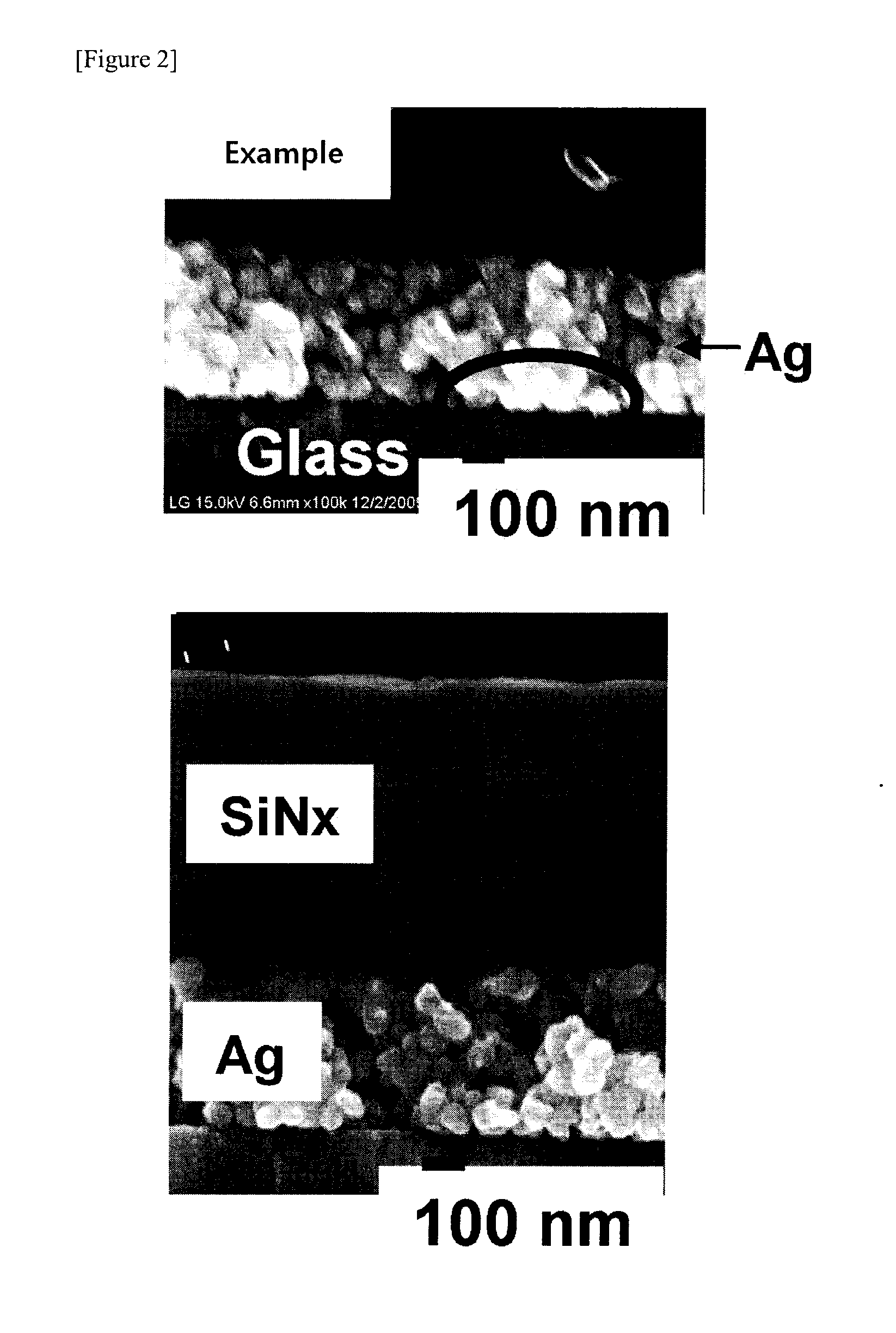Conductive metal ink composition, and method for preparing a conductive pattern
a technology of conductive metal and ink composition, which is applied in the direction of resistive material coating, inks, printing, etc., can solve the problems of reducing the economic efficiency of the whole process, reducing the surface characteristics of the conductive pattern and the physical properties of the final product, and achieving excellent attachment ability and improved conductivity
- Summary
- Abstract
- Description
- Claims
- Application Information
AI Technical Summary
Benefits of technology
Problems solved by technology
Method used
Image
Examples
example
Example 1
Conductive Metal Ink Composition and Formation of Conductive Pattern
[0077]8.57 g of the silver nanoparticles having the average particle diameter of 50 nm, 2.3 g of methyl cellosolve (vapor pressure of 6.2 torr at 25° C.), 7 g of ethanol (vapor pressure of 59.3 torr at 25° C.), 10 g of butyl cellosolve (vapor pressure of 0.76 torr at 25° C.), 0.7 g of Tackirol 160, 0.2 g of BYK® 333 that was the silicon-based surfactant, 0.0857 g of the nickel nanoparticles having the average particle diameter of 100 nm, and 0.004 g of Disperbyk® 180 were mixed with each other, agitated for 24 hours, and filtered by the filter of 1 μm, thus manufacturing the ink composition. The initial viscosity of ink was measured by using the Brookfield viscometer, and as a result thereof, the viscosity was 3.2 cps.
[0078]After the ink composition was coated on the PDMS blanket of the roller, the pattern of the ink composition was formed on the roller by contacting a cliche where the pattern corresponding...
example 2
[0079]8.57 g of the silver nanoparticles having the average particle diameter of 50 nm, 2.3 g of methyl cellosolve (vapor pressure of 6.2 torr at 25° C.), 7 g of ethanol (vapor pressure of 59.3 torr at 25° C.), 10 g of butyl cellosolve (vapor pressure of 0.76 torr at 25° C.), 0.7 g of Tackirol 160, 0.2 g of BYK® 333, 0.0857 g of the tin nanoparticles having the average particle diameter of 100 nm, and 0.01 g of tin(II) (2-ethylhexanoate) were mixed with each other, agitated for 24 hours, and filtered by the filter of 1 μm, thus manufacturing the ink composition. Thereafter, the conductive pattern was formed by using the same method as Example 1, and the physical properties were evaluated by using the same method as Example 1.
example 3
[0080]8.57 g of the silver nanoparticles having the average particle diameter of 50 nm, 2.3 g of methyl cellosolve (vapor pressure of 6.2 torr at 25° C.), 7 g of ethanol (vapor pressure of 59.3 torr at 25° C.), 10 g of butyl cellosolve (vapor pressure of 0.76 torr at 25° C.), 0.7 g of Tackirol 160, 0.8 g of BYK® 337, 0.0857 g of the magnesium oxide nanoparticles having the average particle diameter of 20 nm, and 0.005 g of Disperbyk® 180 were mixed with each other, agitated for 24 hours, and filtered by the filter of 1 thus manufacturing the ink composition. Thereafter, the conductive pattern was formed by using the same method as Example 1, and the physical properties were evaluated by using the same method as Example 1.
PUM
| Property | Measurement | Unit |
|---|---|---|
| Temperature | aaaaa | aaaaa |
| Temperature | aaaaa | aaaaa |
| Time | aaaaa | aaaaa |
Abstract
Description
Claims
Application Information
 Login to View More
Login to View More - R&D
- Intellectual Property
- Life Sciences
- Materials
- Tech Scout
- Unparalleled Data Quality
- Higher Quality Content
- 60% Fewer Hallucinations
Browse by: Latest US Patents, China's latest patents, Technical Efficacy Thesaurus, Application Domain, Technology Topic, Popular Technical Reports.
© 2025 PatSnap. All rights reserved.Legal|Privacy policy|Modern Slavery Act Transparency Statement|Sitemap|About US| Contact US: help@patsnap.com



